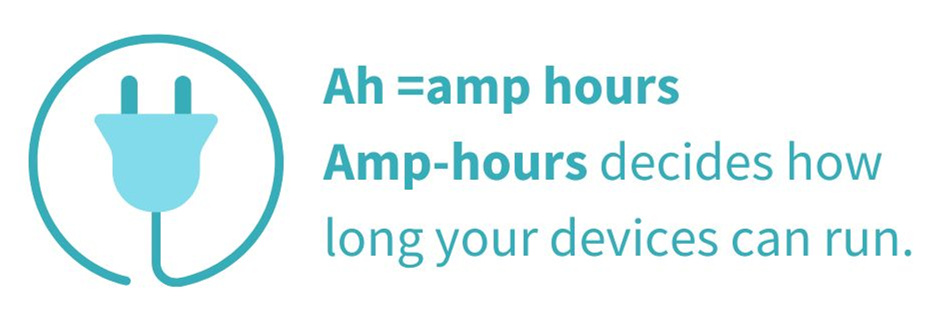What Does Ah Mean On A Battery? | Amp Hour Meaning
Understanding what Amp-Hours are and what it means for your battery
Our world revolves around electricity, a fact that becomes truer every day. A component of electricity availability that's becoming increasingly important is the battery. Batteries are in pretty much everything, from phones, to computers, to cars and even power supplies for homes.
As batteries become more commonplace, have you wondered what all the numbers and ratings on a battery mean? If you've started looking into solar systems for your house or an off-grid property, van, or RV, you've undoubtedly come across ratings like Ah and have questions about what it means.
We will cover some of the ratings and what people mean when talking about battery amps.
Table of contents:
- What is an amp?
- What are amp hours and what does Ah mean in a battery?
- How do you calculate battery capacity?
- What's the difference between amps, ohms, and volts?
- Are AC and DC amps the same?
- Common Ah ratings
- Does a higher Ah battery mean more power?
- Batteries allow flexibility
What is an amp?
Amperage, also known as electric current, measures the rate at which electrons flow through a conductor or object. This rapid flow can be thought of as similar to water flow through a channel or canyon. The higher the amperage, the greater volume of electrons moving.
Basically, amperage can be described as the volume of electrical current. It is an essential indicator of how much energy can be moved by an electric device or system.
What are amp hours and what does Ah mean in a battery?
Amp-hours, or Ah for short, are a unit of measure for a battery's energy capacity. This rating tells us how much current a battery can provide at a specific rate for a certain period.

So, for example, if you have a fully-charged 5-Ah battery, it can provide five amps of current for one hour. If your device requires one amp of current to run at full speed, then the full charge would last about five hours, under ideal conditions, of course.
Many factors affect how long Ah will last in a battery. These include the rate at which the battery charges and discharges, ambient temperature and environment surrounding it, and the overall condition and age. Regardless of these variables, Amp-hours remain an important indicator of how long your devices can reliably run on one charge.
Want more details and examples? This article can help you out: 220 AMP HOUR BATTERIES EXPLAINED.
How do you calculate battery capacity?
Battery capacity, the Ah rating, is calculated by adding up the individual ratings of the cells and then multiplying by the cell count. Other numbers are involved in helping you get an idea of what to expect when using the battery. These values are a more accurate representation of the capability of a battery.
Typically called the C-rate, they represent the battery's charging and discharging ability. Charts and formulas are available online to help calculate what the C-rate on a battery actually means for you.
What's the difference between amps, ohms, and volts?
Electricity is broken down into three standard units, resistance (R), voltage (V), and current (I). Voltage is measured in volts, resistance in ohms, and current in amperage.

We've already covered amps. If we continue our river-in-the-canyon analogy, volts are like the pressure of the water through the canyon, the force pushing the current through.
Ohms are like the width of the canyon. The narrower you make the canyon (or wire), the harder the voltage has to work to push the same amount of amps through. The result is the generation of heat.
Heat causes a loss of electricity, called voltage drop, which also lowers the force the voltage can provide and decreases the amperage that can get through. We minimize resistance through material choices, like copper or aluminum, and increasing the size of the conductors and components used. The less heat that is generated, the better for everything involved.
Click here, you can make more sense of battery voltage and percentages.
Are AC and DC amps the same?
Most people know that AC and DC electricity are two different types of current, but few know how they differ.
What does DC means?
Direct current (DC) is an electric charge that flows consistently in only one direction.
What does AC means?
Alternating current (AC), on the other hand, alternates directions a set number of times per second—60 times per second in the United States.

Batteries are always DC. That's why there is a positive and a negative terminal. It will always flow consistently from one terminal towards the other through the appliance using power. Electrical devices are made to function on either AC or DC, never both, without modification.
If you hook something up to the wrong form of electrical delivery, it won't end well for your devices.
There are ways of converting (or inverting) electricity, you guessed it, using converters (AC to DC) or inverters (DC to AC). That's another article in itself. You can learn what is an inverter and the benefits of pure sine wave inverters in our blogs .
Common Ah ratings
There are many different amp-hour ratings commonly available. When you're dealing with renewable energy batteries like our deep cycle batteries , the more common ones you'll run into are:
●50Ah
●100Ah
●200Ah
It's better to size up than to run the risk of undersizing. You don't want to run out of power on accident because you chose a 200Ah battery when you needed a 250.
Does a higher Ah battery mean more power?
In short, not necessarily.
Even though the Amp=-hours doesn't automatically mean the battery is more powerful by the numbers, sometimes it can equate to more power. In a higher Ah battery, the number and density of cells supplying the current and the heavier gauge of the conductors and components involved allow more current to move with less resistance.
The higher Ah also means you'll be able to power more things for longer with less strain on the battery components. An easier workload will impact the longevity of the battery itself.
Batteries allow flexibility
One of the coolest things about batteries is that you can run them in series or parallel to change voltages and amperage. You can assemble a battery bank to accomplish or fulfill any needs with a few equations.
Getting ready to outfit a van with a renewable energy setup? Or a cabin with off-grid needs? Be sure to check out Renogy’s online store for the best AGM RV battery or lithium ion RV battery.
Related articles:
Is A Solar Battery Necessary For My Solar Energy System?








